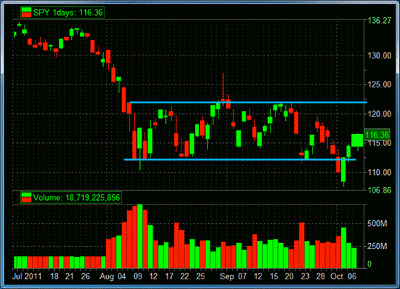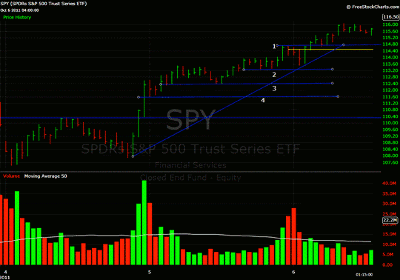Recent market action shows several important considerations for traders when planning and executing short positions in hopes of capitalizing on a short-term bearish reversal.
Over the years, I have seen a very strong tendency for traders to want to be short the market at the first signs of any strength after they have just observed major weakness. It feels like only yesterday a former trader I worked with was shorting the Spyder Trust (SPY) at 76 one or two days after we had put in the March '09 bottom.
I remember walking over to his desk and saying "JZ, we just had a down move in the market of historic proportions; we may continue the uptrend for a little longer." He shrugged at me and a few hours later hit his daily trading loss limit.
I think as traders-and perhaps as humans-we have a tendency to overvalue certain data.
When you see the market drop from 118 to 108 in a few days, it is kind of hard to believe that the market could ever be strong again. But the fact is that since the market broke its long-term uptrend in early August and began consolidating, we have had many more consecutive up closes in SPY than down ones.
Take a look at the big-picture chart below from a few days ago and you will see that each time we moved off the bottom of the range, we trended higher, at least for a few days.
So common sense would dictate after last Tuesday's powerful close that we remind traders on the desk that they should be focused on trading the market on the long side as long as the uptrend remains intact. Of course, this is easier said than done, and most struggled as we moved higher on Wednesday and Thursday.
When the jobs number came out Friday morning and the market popped, we were 10% from Tuesday's low. This indeed seemed like a spot to me where the risk/reward made sense on the short side. I actually shorted the market that day at 117.50 and again at 117, but lost money because I did not follow good risk management rules.
See related: Tough Talk About Risk Management
There is a responsible way to get short a market that has trended higher for a few days in anticipation of a powerful rollover.
Article Continues on Page 2
|pagebreak|Look at the intraday chart below. I have labeled four key support and resistance levels that could have been used to establish and then add to a short position in the market.
I created this chart the second day after the market bottomed, so these particular price levels are no longer relevant, but they can be applied to any two-day period in the market when you are looking for a short-term reversal in trend.
- This was the afternoon high from Day 1. On Day 2, if you fail to trade above this level, you can establish a short position with 25% of our ultimate position size. If this level is breached to the upside, traders should quickly cover their positions, as the uptrend is certainly still intact.
- This was the afternoon support from Day 1, and if it is breached, it can be used as confirmation of a change in short-term momentum. A move below this level and you could add another 25% to your position. This level tends to be more important if it also had served as resistance earlier on Day 1.
- This was the morning and mid-day support from Day 1. Notice that on Day 1 after the market had a small down open it quickly traded above the high from the prior day and then pulled back to this level. A move below this level on Day 2 would have me start to believe a reversal was really taking place, but I probably would not add here. However, after a sharp down move below this level, I might short on retracement.
- This was the opening low from Day 1. This was the market's last chance to bounce. I would be aggressively covering my short here if I saw any type of defense at this level. Now over three points from the high on Day 2 and the last chance for pullback buyers to jump in, so the risk/reward on a short above this level not so good.
- But, if this level gets taken out, then there are a lot of longs that would want out and I would want to be all in on the short, risking 20% of what I had captured on the multi-point down move. This is the trade where the best momentum traders will press their bets on the short side, looking for many to panic out, thus causing another dramatic down move.
Notice that on Day 3 above, the market did initially fail at point 1, allowing a small short to be established, but the market never breached any of the other points and eventually trended higher for the day.
By following these rules, you would never have a large short position and would cover any remaining initial short from point 1 when this level broke to the upside.
The outline above can play out in many slightly different ways depending on how the multi-day support and resistance levels have formed, but the overarching principles are the same: trend/momentum will not change until key inflection points are breached, causing more market participants to feel uncomfortable in their positions and causing them to exit.
By Steve Spencer, trader, SMB Capital























